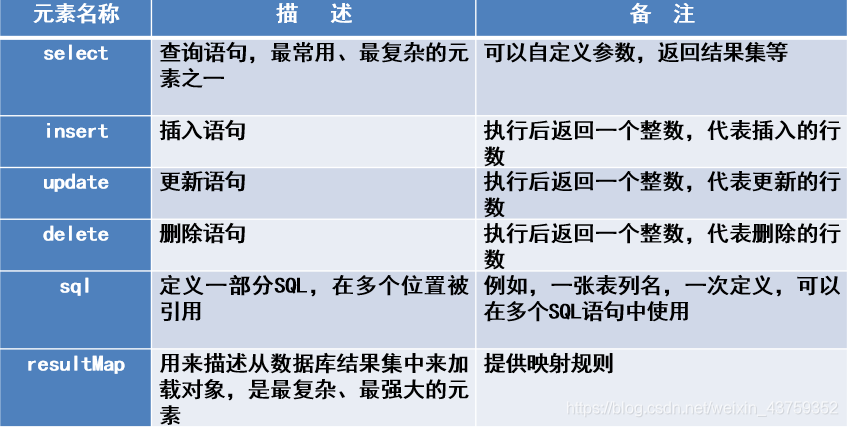在上一篇Mybatis框架(二)Mybatis的入门程序中实现了Mybatis的查找操作,本文章主要实现其余的几种操作,这里不再创建项目,将接着上篇继续操作:
一、我们只需要更该接口StuMapper与Mapper的配置文件中的内容,其余不需要做变动。
编写接口:
Stu getStuById(int id); //根据学生的id查找学生信息
int addStu(Stu stu); //插入一个学生信息
int updateStu(Stu stu); //修改学生的信息
int deleteStu(int id); //删除学生的信息
编写对应的mapper中的sql语句:
<!--根据学生id查找学生的全部信息-->
<select id="getStuById" resultType="com.wst.pojo.Stu" parameterType="int">
/*定义sql*/
select * from stu where id = #{id};
</select>
<!--插入信息-->
<insert id="addStu" parameterType="com.wst.pojo.Stu">
insert into stu (id,name,age,address) values (#{id},#{name},#{age},#{address});
</insert>
<!--<!–修改信息–>-->
<update id="updateStu" parameterType="com.wst.pojo.Stu">
update stu set name = #{name},age=#{age},address=#{address} where id=#{id} ;
</update>
<!--删除信息-->
<delete id="deleteStu" parameterType="int">
delete from stu where id = #{id};
</delete>
注:在上面的配置中主要涉及到的映射器:

二、启动,进行测试。
首先我们需要增加测试函数:
//查询操作
@Test
public void selectStuId(){
SqlSession sqlSession = MyBatisUtils.getSqlSession();
StuMapper mapper = sqlSession.getMapper(StuMapper.class);
System.out.println("根据学生的id查找学生的信息:");
Stu stu=mapper.getStuById(2);
System.out.println(stu);
//关闭sqlsession
sqlSession.close();
}
//插入操作
@Test
public void insertStu(){
SqlSession sqlSession = MyBatisUtils.getSqlSession();
StuMapper mapper = sqlSession.getMapper(StuMapper.class);
System.out.println("插入学生信息:");
int m= mapper.addStu(new Stu(10,"XX",12,"XX"));
if (m>0) {
System.out.println("插入成功!");
}
sqlSession.commit();
sqlSession.close();
}
//更新操作
@Test
public void updateStu(){
SqlSession sqlSession = MyBatisUtils.getSqlSession();
StuMapper mapper = sqlSession.getMapper(StuMapper.class);
System.out.println("更新学生信息:");
mapper.updateStu(new Stu(1,"XX",10,"XX"));
sqlSession.commit();
System.out.println("更新成功!");
sqlSession.close();
}
//删除操作
@Test
public void deleteStu(){
SqlSession sqlSession = MyBatisUtils.getSqlSession();
StuMapper mapper = sqlSession.getMapper(StuMapper.class);
System.out.println("删除学生信息:");
mapper.deleteStu(2);
sqlSession.commit();
System.out.println("删除成功!!!");
sqlSession.close();
}
注:
























 341
341











 被折叠的 条评论
为什么被折叠?
被折叠的 条评论
为什么被折叠?










